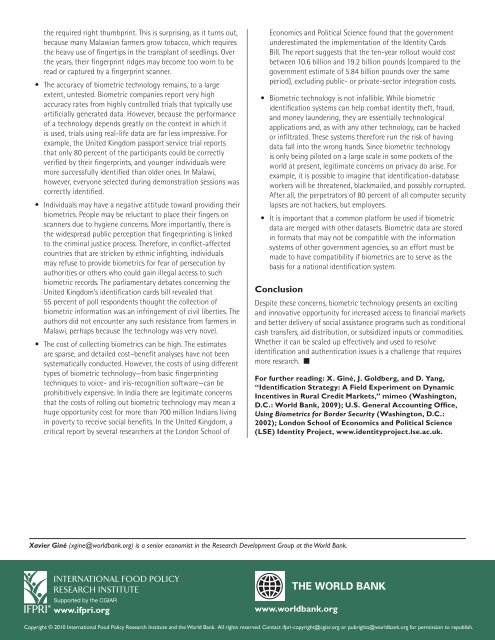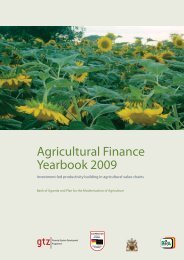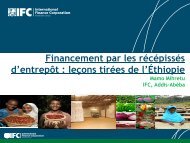<strong>Innovations</strong> <strong>in</strong> <strong>Rural</strong> <strong>and</strong> <strong>Agriculture</strong> F<strong>in</strong>anceBiometric Technology <strong>in</strong> <strong>Rural</strong> Credit Markets: The Case of MalawiXavier G<strong>in</strong>éFor Food, <strong>Agriculture</strong>,<strong>and</strong> the EnvironmentFocus 18 • Brief 9 • July 2010dentity theft is a common crime the world over. In develop<strong>in</strong>gI countries, the damage caused by identity theft <strong>and</strong> identity fraudgoes far beyond the <strong>in</strong>dividual victim, however, <strong>and</strong> ultimatelycreates a direct impediment to progress, particularly <strong>in</strong> creditmarkets. Recent research reveals that biometric technology can helpreduce these problems.A biometric is a measurement of physical or behavioralcharacteristics used to verify or analyze identity. Commonbiometrics <strong>in</strong>clude a person’s f<strong>in</strong>gerpr<strong>in</strong>ts; face, iris, or ret<strong>in</strong>apatterns; speech; or h<strong>and</strong>written signature. These are effectivepersonal identifiers because they are unique <strong>and</strong> <strong>in</strong>tr<strong>in</strong>sic to eachperson, so, unlike conventional identification methods (such aspassport numbers or government-issued identification cards), theycannot be forgotten, lost, or stolen.Recent advances <strong>in</strong> recognition technology coupled with<strong>in</strong>creases <strong>in</strong> both digital storage capacity <strong>and</strong> computer process<strong>in</strong>gspeeds have made biometric technology (for example, ocular orf<strong>in</strong>gerpr<strong>in</strong>t scanners) feasible <strong>in</strong> many applications, from controll<strong>in</strong>grestricted build<strong>in</strong>g access to allow<strong>in</strong>g more effective delivery oftargeted government programs with large-scale identificationsystems, such as those be<strong>in</strong>g implemented <strong>in</strong> India by the UniqueIdentification Authority of India.Biometric technology can also improve access to credit<strong>and</strong> <strong>in</strong>surance markets, especially <strong>in</strong> countries that do not havea unique identification system, where identity fraud—the useof someone else’s identity or a fictitious one—to ga<strong>in</strong> access toservices otherwise unavailable to an <strong>in</strong>dividual is rather common.For example, lenders <strong>in</strong> Malawi describe past borrowers whopurposefully defaulted then tried to obta<strong>in</strong> a fresh loan from thesame or another <strong>in</strong>stitution under a false identity. And, althoughless common <strong>in</strong> develop<strong>in</strong>g countries because markets are lessdeveloped, the potential for sick <strong>in</strong>dividuals without healthcarecoverage to use the <strong>in</strong>surance policy of a friend or relative doesexist. The response of lenders <strong>and</strong> <strong>in</strong>surance companies has been torestrict the supply of such services to the detriment of the greaterpopulation, not just those people committ<strong>in</strong>g identity fraud.In the case of credit, biometric technology can make the idea offuture credit denial more than an empty threat by mak<strong>in</strong>g it easierfor f<strong>in</strong>ancial <strong>in</strong>stitutions to withhold new loans from past defaulters<strong>and</strong> reward responsible past borrowers with <strong>in</strong>creased credit. As aresult of this <strong>in</strong>ability to “cheat the system,” <strong>in</strong>dividuals may takeout smaller loans that they are able to repay or avoid borrow<strong>in</strong>galtogether if they cannot pay back any debt. Borrowers may havegreater <strong>in</strong>centives to ensure that production is successful, either byexert<strong>in</strong>g more effort or choos<strong>in</strong>g less risky projects, <strong>and</strong>—wheneverproduction could cover the loan repayment—borrowers may be lesslikely to default <strong>in</strong>tentionally or opportunistically.To look at the impact of biometric technology, G<strong>in</strong>é, Goldberg,<strong>and</strong> Yang (2009) implemented a field experiment us<strong>in</strong>g3,200 smallholder paprika farmers <strong>in</strong> four locations <strong>in</strong> Malawi whoapplied for an agricultural <strong>in</strong>put loan <strong>in</strong> 2007. Farmers <strong>in</strong> the studywere r<strong>and</strong>omly allocated to either a control group or a treatmentgroup; each member <strong>in</strong> the latter group had a f<strong>in</strong>gerpr<strong>in</strong>t collectedas part of their loan application <strong>and</strong> an explanation that this wouldbe used to determ<strong>in</strong>e their identity on any future applications.(F<strong>in</strong>gerpr<strong>in</strong>t recognition was used <strong>in</strong>stead of face, iris, or ret<strong>in</strong>arecognition because the technology has been commercially availables<strong>in</strong>ce the early 1970s, <strong>and</strong> there is a highly competitive market forit. Therefore, it is <strong>in</strong>expensive, well known, <strong>and</strong> widely used.) Bothtreatment <strong>and</strong> control groups were given a tra<strong>in</strong><strong>in</strong>g session on theimportance of credit history <strong>in</strong> ensur<strong>in</strong>g future access to credit.The study shows that with<strong>in</strong> the subgroup of farmers who hadthe highest ex ante default risk, f<strong>in</strong>gerpr<strong>in</strong>t<strong>in</strong>g led to <strong>in</strong>creases <strong>in</strong>repayment rates of about 40 percent. By contrast, f<strong>in</strong>gerpr<strong>in</strong>t<strong>in</strong>g hadno impact on repayment for farmers with low ex ante default risk.These higher repayment rates are due to f<strong>in</strong>gerpr<strong>in</strong>ted borrowersrequest<strong>in</strong>g smaller loan amounts to ensure they would be able torepay them <strong>and</strong> devot<strong>in</strong>g more l<strong>and</strong> <strong>and</strong> <strong>in</strong>puts to paprika, thusdivert<strong>in</strong>g fewer resources to other crops; the same cannot be saidfor their nonf<strong>in</strong>gerpr<strong>in</strong>ted counterparts.A rough cost–benefit analysis of the pilot experiment suggeststhat the benefits from improved repayment greatly outweigh thecosts of biometric equipment <strong>and</strong> f<strong>in</strong>gerpr<strong>in</strong>t collection, whichaccounts for basic tra<strong>in</strong><strong>in</strong>g <strong>and</strong> the time it takes credit officersto collect biometric data. These costs, however, do not <strong>in</strong>cludea full implementation plan, which would likely require software<strong>in</strong>tegration, exp<strong>and</strong>ed data-storage facilities, upgraded equipment,<strong>and</strong> more <strong>in</strong>-depth staff tra<strong>in</strong><strong>in</strong>g.Challenges <strong>in</strong> the implementationof biometric systemsDespite the encourag<strong>in</strong>g results from the pilot <strong>in</strong> Malawi <strong>and</strong>the success of biometric technology <strong>in</strong> controlled laboratoryenvironments, there are still concerns <strong>and</strong> challenges whencollect<strong>in</strong>g <strong>and</strong> us<strong>in</strong>g such <strong>in</strong>formation <strong>in</strong> real life <strong>and</strong> when try<strong>in</strong>g toestablish an identification system at a national level.• Not everyone can participate <strong>in</strong> a f<strong>in</strong>gerpr<strong>in</strong>t-basedidentification system. F<strong>in</strong>gerpr<strong>in</strong>ts can be unrecognizabledue to cuts or burns. In addition, older <strong>in</strong>dividuals may havef<strong>in</strong>gerpr<strong>in</strong>ts that have worn with age, <strong>and</strong> the operation off<strong>in</strong>gerpr<strong>in</strong>t readers may be jeopardized due to arthritis. In someareas, especially those with past or present conflict, <strong>in</strong>dividualsmay lack f<strong>in</strong>gers altogether. In the most comprehensive studyto test the process <strong>and</strong> customer attitude dur<strong>in</strong>g the record<strong>in</strong>gof biometric <strong>in</strong>formation, the United K<strong>in</strong>gdom passport servicetrial reports an enrollment success rate of 100 percent for the9,250 nondisabled participants <strong>and</strong> 96 percent for the750 disabled participants. In Malawi, only about 2 percent ofthe sample of 1,600 f<strong>in</strong>gerpr<strong>in</strong>ted farmers had to have theirleft thumbpr<strong>in</strong>t recorded when the scanner failed to capture
the required right thumbpr<strong>in</strong>t. This is surpris<strong>in</strong>g, as it turns out,because many Malawian farmers grow tobacco, which requiresthe heavy use of f<strong>in</strong>gertips <strong>in</strong> the transplant of seedl<strong>in</strong>gs. Overthe years, their f<strong>in</strong>gerpr<strong>in</strong>t ridges may become too worn to beread or captured by a f<strong>in</strong>gerpr<strong>in</strong>t scanner.• The accuracy of biometric technology rema<strong>in</strong>s, to a largeextent, untested. Biometric companies report very highaccuracy rates from highly controlled trials that typically useartificially generated data. However, because the performanceof a technology depends greatly on the context <strong>in</strong> which itis used, trials us<strong>in</strong>g real-life data are far less impressive. Forexample, the United K<strong>in</strong>gdom passport service trial reportsthat only 80 percent of the participants could be correctlyverified by their f<strong>in</strong>gerpr<strong>in</strong>ts, <strong>and</strong> younger <strong>in</strong>dividuals weremore successfully identified than older ones. In Malawi,however, everyone selected dur<strong>in</strong>g demonstration sessions wascorrectly identified.• Individuals may have a negative attitude toward provid<strong>in</strong>g theirbiometrics. People may be reluctant to place their f<strong>in</strong>gers onscanners due to hygiene concerns. More importantly, there isthe widespread public perception that f<strong>in</strong>gerpr<strong>in</strong>t<strong>in</strong>g is l<strong>in</strong>kedto the crim<strong>in</strong>al justice process. Therefore, <strong>in</strong> conflict-affectedcountries that are stricken by ethnic <strong>in</strong>fight<strong>in</strong>g, <strong>in</strong>dividualsmay refuse to provide biometrics for fear of persecution byauthorities or others who could ga<strong>in</strong> illegal access to suchbiometric records. The parliamentary debates concern<strong>in</strong>g theUnited K<strong>in</strong>gdom’s identification cards bill revealed that55 percent of poll respondents thought the collection ofbiometric <strong>in</strong>formation was an <strong>in</strong>fr<strong>in</strong>gement of civil liberties. Theauthors did not encounter any such resistance from farmers <strong>in</strong>Malawi, perhaps because the technology was very novel.• The cost of collect<strong>in</strong>g biometrics can be high. The estimatesare sparse, <strong>and</strong> detailed cost–benefit analyses have not beensystematically conducted. However, the costs of us<strong>in</strong>g differenttypes of biometric technology—from basic f<strong>in</strong>gerpr<strong>in</strong>t<strong>in</strong>gtechniques to voice- <strong>and</strong> iris-recognition software—can beprohibitively expensive. In India there are legitimate concernsthat the costs of roll<strong>in</strong>g out biometric technology may mean ahuge opportunity cost for more than 700 million Indians liv<strong>in</strong>g<strong>in</strong> poverty to receive social benefits. In the United K<strong>in</strong>gdom, acritical report by several researchers at the London School ofEconomics <strong>and</strong> Political Science found that the governmentunderestimated the implementation of the Identity CardsBill. The report suggests that the ten-year rollout would costbetween 10.6 billion <strong>and</strong> 19.2 billion pounds (compared to thegovernment estimate of 5.84 billion pounds over the sameperiod), exclud<strong>in</strong>g public- or private-sector <strong>in</strong>tegration costs.• Biometric technology is not <strong>in</strong>fallible. While biometricidentification systems can help combat identity theft, fraud,<strong>and</strong> money launder<strong>in</strong>g, they are essentially technologicalapplications <strong>and</strong>, as with any other technology, can be hackedor <strong>in</strong>filtrated. These systems therefore run the risk of hav<strong>in</strong>gdata fall <strong>in</strong>to the wrong h<strong>and</strong>s. S<strong>in</strong>ce biometric technologyis only be<strong>in</strong>g piloted on a large scale <strong>in</strong> some pockets of theworld at present, legitimate concerns on privacy do arise. Forexample, it is possible to imag<strong>in</strong>e that identification-databaseworkers will be threatened, blackmailed, <strong>and</strong> possibly corrupted.After all, the perpetrators of 80 percent of all computer securitylapses are not hackers, but employees.• It is important that a common platform be used if biometricdata are merged with other datasets. Biometric data are stored<strong>in</strong> formats that may not be compatible with the <strong>in</strong>formationsystems of other government agencies, so an effort must bemade to have compatibility if biometrics are to serve as thebasis for a national identification system.ConclusionDespite these concerns, biometric technology presents an excit<strong>in</strong>g<strong>and</strong> <strong>in</strong>novative opportunity for <strong>in</strong>creased access to f<strong>in</strong>ancial markets<strong>and</strong> better delivery of social assistance programs such as conditionalcash transfers, aid distribution, or subsidized <strong>in</strong>puts or commodities.Whether it can be scaled up effectively <strong>and</strong> used to resolveidentification <strong>and</strong> authentication issues is a challenge that requiresmore research. nFor further read<strong>in</strong>g: X. G<strong>in</strong>é, J. Goldberg, <strong>and</strong> D. Yang,“Identification Strategy: A Field Experiment on DynamicIncentives <strong>in</strong> <strong>Rural</strong> Credit Markets,” mimeo (Wash<strong>in</strong>gton,D.C.: World Bank, 2009); U.S. General Account<strong>in</strong>g Office,Us<strong>in</strong>g Biometrics for Border Security (Wash<strong>in</strong>gton, D.C.:2002); London School of Economics <strong>and</strong> Political Science(LSE) Identity Project, www.identityproject.lse.ac.uk.Xavier G<strong>in</strong>é (xg<strong>in</strong>e@worldbank.org) is a senior economist <strong>in</strong> the Research Development Group at the World Bank.International Food PolicyResearch InstituteSupported susta<strong>in</strong>able solutions by the for CGIAR end<strong>in</strong>g hunger <strong>and</strong> povertywww.ifpri.orgSupported by the CGIARwww.worldbank.orgCopyright © 2010 International Food Policy Research Institute <strong>and</strong> the World Bank. All rights reserved. Contact ifpri-copyright@cgiar.org or pubrights@worldbank.org for permission to republish.







